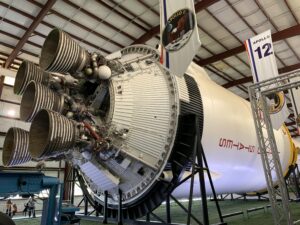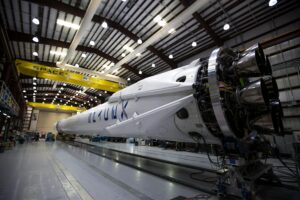
Space exploration is getting a big boost from reusable rocket technology. Companies like SpaceX and Blue Origin are making huge strides. They’re making rockets land safely after launch.
By reusing rocket parts, they’re cutting costs. This opens up more opportunities for missions. Rocket reusability innovations are making cheaper satellite launches and Mars trips possible.
These space exploration advancements are exciting for everyone. Whether you love tech or just follow space news, this guide is for you. It explains how rockets can return to Earth safely and why it’s important.
Learn about rockets like SpaceX’s Falcon 9 and Blue Origin’s New Glenn. They’re changing the space game.
Key Takeaways
- Reusable rockets cut launch costs by up to 30% compared to traditional methods.
- Rocket reusability innovations enable faster mission schedules and more science in space.
- Major players like SpaceX and Blue Origin lead global space technology breakthroughs.
- Lightweight materials and smart software drive reusable rocket technology progress.
- These advancements make space more accessible for research, business, and even travel.
The Evolution of Reusable Rocket Technology
Space exploration used to rely on single-use rockets. But, the history of reusable rockets shows a long journey to change this. Early missions like Apollo threw away boosters after each flight, making space travel very expensive. Now, thanks to the rocket technology evolution, we aim to return rockets to Earth safely.
From Expendable to Reusable: A Paradigm Shift
Before the 1980s, every rocket part was lost after launch. The Space Shuttle program was a big step, trying to reuse parts like the orbiter and booster rockets. Though it was a start, space shuttle reusability had its challenges—high maintenance costs and two tragedies. Yet, it paved the way for today’s reusable rockets.
Early Attempts at Reusability
“The Space Shuttle was a first step toward sustainable spaceflight, but we’re still learning how to perfect it.”
Early tries faced many challenges. The shuttle’s tiles, engines, and landing gear needed a lot of repairs after each flight. This made it far from truly reusable. But, private companies like SpaceX later found ways to overcome these issues.
They simplified designs and focused on quick turnaround. This approach cut costs by using automation and new materials.
The Economic Case for Reusability
Now, making space travel affordable drives innovation. Reusable rockets save a lot of money. For example, SpaceX’s Falcon 9 can cut launch costs by up to 30% per flight. Instead of taking years, companies can refurbish boosters in weeks, allowing for more missions.
This change opens up new possibilities. It makes space travel affordable for more people. The goal is to make space a regular destination, one that’s accessible to everyone.
How Reusable Rockets Are Transforming Space Exploration
Imagine launching satellites, cargo, and even humans into space with the same rockets multiple times. The impact of reusable rockets is already changing space missions. They cut costs and increase space mission frequency.
Companies like SpaceX and Blue Origin now plan missions months ahead. This is thanks to rockets that can safely return to Earth.
“Reusable rockets are the key to unlocking the solar system.” — Elon Musk, SpaceX
- More launches mean faster satellite deployment for global internet coverage or climate monitoring.
- Rocket reuse reduces costs by up to 30%, opening space accessibility to startups and smaller nations.
- Commercial space opportunities now include space tourism, asteroid mining, and lunar landing services.
Pictures from Mars rovers or space station resupply missions used to take years to plan. Today, reused rockets shorten timelines. Universities and private firms can affordably test tech in orbit, fostering innovation.
Even countries without space agencies partner with commercial providers to launch payloads.
Think of it as spaceflight’s version of airplanes: frequent, predictable, and accessible to more users. The next decade will see weekly launches. They will enable everything from asteroid mining to Mars colony prep—all powered by rockets that fly again and again.
SpaceX’s Contribution to Reusable Rocket Innovation
SpaceX has changed space travel with its SpaceX rocket technology. It makes space travel cheaper and opens up new areas. This makes space travel possible for more missions.
The Falcon 9 Revolution
The Falcon 9 reusability changed rocket economics. Its first landing in 2015 showed rockets could fly again. Now, Falcon 9 boosters launch satellites, resupply the ISS, and carry astronauts.
Starship Development: A Game-Changer
Starship development aims to take humans to Mars. It has key features:
- Stainless steel hull for extreme temperature tolerance
- Full reusability for cost efficiency
- Propulsion by 37 Raptor engines in future configurations
Landing and Recovery Systems
| Stage | Process |
|---|---|
| Re-entry | Heat shields protect during atmospheric entry |
| Guided Descent | Grid fins steer the booster back |
| Touchdown | Engine burns slow the rocket to a vertical landing |
Raptor Engine Innovations
The Raptor engine innovations power Starship’s dreams. They use a full-flow staged combustion cycle for more thrust and efficiency. Early tests show they are twice as powerful as Merlin engines.
“Failure is an option here. If things are not failing, you are not innovating enough.” – Elon Musk
These engines help launch rockets quickly. This is key to SpaceX’s reusable vision.
Blue Origin’s New Shepard and New Glenn Systems

Blue Origin is changing how we reuse space technology. Their New Shepard system is for short trips to space, landing vertically with great accuracy. Unlike SpaceX, Blue Origin takes a slow and steady approach. This method makes sure their tech is reliable and ready for space tourism and launching satellites.
Vertical Landing Precision
The New Shepard system lands with incredible precision. It uses special sensors and thrusters to land just inches from the launch pad. This precision helps the system last longer, making it ready for commercial use.
Reusable Booster Design
| Rocket | Purpose | Reusability |
|---|---|---|
| New Shepard | Suborbital tourism | Full booster reuse after vertical landing |
| New Glenn | Orbital launches | Staged recovery for heavy payloads |
Blue Origin’s New Glenn development is for launching satellites into orbit. It has a strong first stage with seven engines. This design is built to last, making it cheaper for launching satellites over time.
Tourism and Commercial Applications
“We go step by step, ferociously,” Jeff Bezos once said, highlighting Blue Origin’s deliberate pace. This mindset shapes their space tourism rockets, designed with passenger safety and comfort as top priorities. Capsules feature large windows and pressurized cabins, offering serene views during zero-G experiences.
By 2024, the New Shepard will take paying customers on 11-minute flights. The New Glenn will serve corporate clients for satellite launches. Both systems aim to make space travel accessible for science, tourism, and business.
The Latest Breakthroughs in Reusable Rocket Technology
Recent rocket innovations are changing how rockets land and take off again. New space technology makes landings smoother and flights quicker. Engineers are working on heat shields that can handle multiple reentries, making rockets last longer.
Next-generation launch systems now have automated tools for quick checks. These tools cut down refurbishment time by 40% compared to old models.
- Landing precision: GPS-guided fins and thrusters reduce touchdown errors to within 3 meters, improving safety.
- Engine durability: Rocket engineering advances let engines endure 10+ launches with minimal maintenance.
- 3D-printed parts: Custom-printed nozzles and fuel tanks slash production costs by up to 30%.
Companies like SpaceX and Blue Origin use AI for virtual tests before real launches. These advances mean more missions at lower costs. They’re even looking into modular designs for rocket stages, making repairs quicker.
This could lead to a future where space travel is as common as flying on airplanes.
Materials Science Innovations Enabling Reusability
Behind the scenes of rocket reusability, a quiet revolution is happening in aerospace materials innovation. Rockets face extreme stress when they return from space. This includes scorching heat and cold. Engineers are working hard to create materials that can handle these challenges.
Heat-Resistant Alloys and Composites
Imagine protecting a rocket from 3,000°F flames during descent. Heat shields for rockets now use advanced materials. These include carbon composites and ceramic tiles that can bend without breaking.
SpaceX’s Starship has a stainless steel nosecone designed for multiple fiery returns. These materials don’t just survive heat; they get stronger after each flight.
Cryogenic Tank Developments
Storing super-chilled fuels like liquid oxygen or methane is a big challenge. Engineers create cryogenic fuel containers from ultra-lightweight alloys like aluminum-lithium. These containers prevent damage from frostbite-like conditions while keeping fuel at -300°F.
Blue Origin’s New Glenn uses similar technology to protect its propellant tanks. This is crucial during launches and landings.
Lightweight Structural Components
Every pound saved in materials means more room for payloads. Carbon fiber and titanium grid fins cut weight by 40% compared to older designs. Rocket material science now focuses on balancing strength and flexibility.
For example, SpaceX’s Falcon 9 uses carbon-fiber interstage sections. These sections don’t crack under launch vibrations.
These breakthroughs aren’t just lab experiments—they’re flying today. Next time you see a rocket land, remember: its survival depends on materials that push the limits of science and engineering.
Propulsion Systems: Advancements Driving Reusability
Today, reusable rocket engines are made to last through many launches. They are built to withstand the harsh conditions of repeated flights. This is a big change from the old days when engines were only used once.
Engineers have come up with new cooling systems. They use advanced materials to keep the engine cool during the intense heat of launch and landing. This helps prevent damage and makes the engines more durable.
Now, imagine an engine that can handle dozens of flights instead of just one. Thanks to smart throttling systems, these engines can adjust their power during landing. This reduces the stress on the engine.
Sensors track the engine’s temperature and pressure in real time. This lets teams catch any signs of wear early. Companies like SpaceX and Blue Origin can save a lot of money by reusing these engines.
SpaceX’s Raptor engine is a big leap forward. It uses regenerative cooling to stay strong over 10+ flights. Blue Origin’s BE-4 engine also focuses on durability, with features like reinforced nozzles and thermal shields.
These innovations don’t just save money. They also make it possible to launch into space more often. This opens up new possibilities for space exploration and development.
Software and AI in Modern Reusable Rocket Systems

Every rocket landing success is thanks to rocket landing software and AI in aerospace. These tools help rockets land safely and reliably. They work faster than humans, guiding rockets back to Earth.
- Autonomous Landing Algorithms adjust thrust and angle for landing. SpaceX’s Falcon 9 uses over 200 sensors for precise landing, even with changing winds.
- AI in aerospace checks engine performance in flight. It predicts fuel needs and makes adjustments for safe landing.
- Predictive maintenance tools spot problems early. They look at heat shield data and engine vibrations to plan repairs before they’re needed.
Autonomous Landing Algorithms
Every Falcon 9 landing uses rocket landing software to analyze 30,000 data points per second. This ensures a precise vertical landing on ocean platforms.
Real-Time Flight Adjustments
“AI lets rockets ‘think’ during flight. Without it, reusability would still be theoretical.” — Elon Musk, SpaceX
Predictive Maintenance for Rocket Components
| Traditional Methods | Predictive AI Systems |
|---|---|
| Manual inspections post-flight | Data-driven diagnostics during flight |
| Routine part replacements | Component-specific repair schedules |
These systems adjust to weather and spot engine issues. They keep rockets flying longer. Next time you see a launch, remember: it’s code and algorithms making it happen.
Economic Impact: How Reusable Rockets Are Reducing Space Access Costs
Reusable rockets are changing the space industry economics by lowering rocket launch costs. Companies save millions on each flight. This makes space missions more affordable for industries beyond the usual players. It’s driving innovation in the commercial space market.
Launch Cost Comparisons
| Rocket Type | Traditional Cost | Reusable Cost | Savings |
|---|---|---|---|
| Falcon 9 | $62M | $30M | 51.6% |
Reusable rockets cut costs by 50% or more. SpaceX’s Falcon 9 now costs $30 million per flight. This is half the $62 million for expendable rockets. Such savings allow companies like Maxar or Planet to launch satellites affordably.
Refurbishment Economics
Refurbishing rockets is cheaper than building new ones. SpaceX spends ~$3 million to repair engines, thermal shields, and avionics after each flight. This is a fraction of the $50+ million to build a new rocket.
Market Disruption Effects
- Telecom firms launch larger satellite networks
- Insurance costs drop for payloads
- New space logistics companies emerge
Lower cost of refurbishing rockets lets startups compete. Companies like Astra now offer small-sat launches for under $1M. This opens space to research and education sectors. Traditional firms like ULA now focus on reusability to stay competitive.
Environmental Benefits of Rocket Reusability
Reusable rockets are not just cheaper; they’re a big step forward for green space technology. When a rocket stage comes back, it means no need to build new parts. This saves energy and materials, which helps reduce space industry pollution. It’s like recycling a car instead of buying a new one every time.
Old rockets often throw away parts that burn up or crash into the sea. But reusable rockets cut down on this waste and emissions. For instance, SpaceX’s Raptor engines use methane, a cleaner fuel than the old kerosene. This change makes rockets less harmful to the environment.
- Reusable rockets reduce manufacturing waste by 90% per launch.
- Methane-based propulsion cuts carbon emissions by up to 30% compared to legacy fuels.
- Less debris in oceans and atmosphere protects wildlife and ecosystems.
“Sustainable rocket launches aren’t optional—they’re essential for long-term space exploration,” said a NASA sustainability report. “Every reused rocket means fewer resources consumed and less harm to our planet.”
Companies like Blue Origin and SpaceX are making sustainable rocket launches a priority. Imagine rockets flying hundreds of times, each time saving resources. This move is similar to the trend of greener aviation and transportation. By focusing on reusability, the space industry is working towards a future where space travel doesn’t harm our planet.
Challenges Still Facing Reusable Rocket Technology
Reusable rockets aim to make space travel cheaper. But, engineers face many challenges that slow progress. Let’s look at the technical and operational issues holding back this tech.
“The hardest part isn’t the launch—it’s getting the rocket ready for the next mission.” – Rocket Engineer, NASA
Thermal Protection Issues
Spacecraft need to survive 3,000°F heat during reentry. Current materials wear out after repeated use, leading to expensive replacements. Researchers are testing new composites to handle extreme heat without failing.
Refurbishment Complexity
Rocket maintenance is time-consuming and costly. Each flight stresses engines and fuel tanks, causing damage. Teams spend weeks checking components for hidden damage, slowing down the process.
Fuel Efficiency Tradeoffs
Saving fuel for landing reduces space vehicle efficiency. Engineers must balance saving propellant for return trips with maximizing payload. Boil-off losses and engine wear from multiple ignitions make it even harder.
Even small issues like cracks or software glitches can keep rockets grounded for weeks. Overcoming these challenges will make reusable rockets a regular part of spaceflight.
How Reusable Rockets Will Shape Your Future

Reusable rockets are changing the future of space travel and our daily lives. They make launching things into space cheaper. This means we could see everyday space technology benefits soon, like how we use our smartphones today.
Let’s look at how these new technologies might change your world.
- Global internet access: SpaceX’s Starlink is already bringing broadband to remote places. With reusable rockets, this could reach even more areas, bringing fast internet to your town.
- Clean energy breakthroughs: Space-based solar power stations are now possible thanks to cheaper launches. They might send clean energy to Earth, lowering your carbon footprint.
- Medical advances: Research in space could speed up finding new medicines. This could bring treatments for diseases like cancer or Alzheimer’s to you faster, thanks to space lab experiments.
- Affordable space tourism: Reusable rockets could make space travel cheaper. Your next vacation might include a trip to space, not just a beach.
Earth also benefits from reusable rockets. Better weather satellites could predict storms more accurately, keeping your community safe. Orbiting sensors might help farmers near you grow crops better.
The space innovation impact isn’t just in space—it’s here on Earth. Imagine cheaper disaster relief supplies launched quickly after emergencies. Or 3D-printed parts made in orbit improving tools in hospitals or schools.
This tech is not far away—it’s the start of a new era. Your daily life, from energy bills to healthcare, could change as rockets open up new possibilities. The sky’s no longer the limit.
Global Race: International Developments in Reusable Rocket Tech
Reusable rockets are changing how we access space, sparking a global race. Countries and companies are pushing the limits, facing both challenges and opportunities. Let’s see how the world is shaping this new frontier.
China’s Long March Reusable Initiatives
China’s Chinese reusable rockets are advancing quickly. The Long March 8 and 9 are testing new grid-fin systems, like SpaceX’s. They’ve successfully landed prototypes, showing they’re getting closer to making reusability routine.
This move is part of China’s plan to be a leader in space technology by 2030.
European Space Agency Approaches
The ESA focuses on sustainable space travel with its European space technology. They’re working on the Prometheus engine, designed for many flights. It uses new manufacturing methods to save money.
Their Themis project, set for 2025, aims to test reusing rocket stages in short flights. Europe is taking a careful approach, aiming for reliability over speed.
Emerging Private Companies Worldwide
New global aerospace companies are shaking things up. Startups like:
- Japan’s Interstellar Technologies (testing methane-fueled prototypes)
- India’s Agnikul Cosmos (affordable smallsat launchers)
- Israel’s SpaceIL (post-Beresheet lunar ambitions)
These companies use new designs and AI to innovate fast. They’re challenging big names like Arianespace and Rocket Lab.
Conclusion: The Promising Horizon of Reusable Rocket Technology
Reusable rockets are changing the game in space technology. Companies like SpaceX and Blue Origin are making rockets better. This means more missions can explore space, like sending satellites to orbit or even mining asteroids.
Imagine going to the Moon or living on other planets. Thanks to new materials and landing tech, these dreams are closer to reality. Reusable rockets are making these goals possible.
Starship’s tests and new players in the market show space travel is becoming routine. Though challenges like engine updates and fuel efficiency exist, progress is fast. Companies globally, from China to the ESA, are pushing the limits.
The goal now is to mix innovation with reliability. This will make space travel a normal part of our lives. As these systems get better, expect cheaper satellite launches and more private space missions.
Sustainable space access is becoming a reality. The next decade might see the first commercial Moon bases or Mars cargo deliveries. This isn’t science fiction; it’s our future in space.
FAQ
What are reusable rockets?
Reusable rockets are launch systems made to be used over and over. They cut down the cost of getting to space. This is because parts like boosters can be fixed and launched again.
How do reusable rockets benefit space exploration?
They make launching things into space cheaper and more frequent. They also make missions more reliable. This opens up space for more companies and countries to explore.
What companies are leading in reusable rocket technology?
SpaceX and Blue Origin are leading the way. SpaceX’s Falcon 9 is a reliable reusable rocket. Blue Origin’s New Shepard is for suborbital flights and space tourism.
What is the economic impact of reusable rockets?
Reusable rockets are making space travel cheaper. They’re changing the launch market. This makes it easier to launch satellites and other missions, encouraging new ideas and businesses in space.
Are there environmental benefits to reusable rockets?
Yes, they help the environment. Reusing rockets means making fewer new parts. This cuts down on carbon emissions and space junk.
What challenges still exist in reusable rocket technology?
There are still hurdles to overcome. These include protecting rockets from heat during landing and making them fuel-efficient. Engineers are working hard to solve these problems.
How does AI contribute to the functionality of reusable rockets?
AI is key for reusable rockets. It helps with landing, adjusting during flight, and keeping parts in good shape. This makes reusable rockets more precise and cost-effective.
What future advancements can we expect in reusable rocket technology?
We can look forward to better materials and propulsion systems. These will make reusable rockets even more efficient. They could also be used for new things like space-based solar power and satellite internet.













